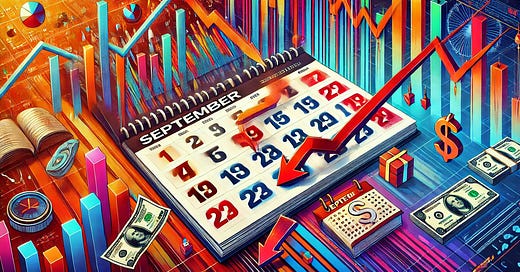Before we get started, I wanted to let you know the third episode of my new podcast Room to Run is live on Spotify and Apple Podcasts.
In this week’s episode we discussed:
How much longer will the bull run last?
One Magnificent Seven tech stock I’d buy (and one I’d avoid)
What to expect from Jerome Powell’s speech on Wednesday
Preview of next week’s market moving events
Each 10-minute episode can be listened to for FREE on Spotify and Apple Podcasts. If you enjoy the podcast, please leave a review.
This is the worst time of the year for the stock market.
If you’ve followed my work, you know that I’m usually cautiously optimistic about the market. This makes sense as the S&P 500 has finished in positive territory 75% of years over the last century returning ~10% per year. Yes, crashes happen, but are extremely rare, and I don’t run around trying to predict them since they are unpredictable.
But I’ve also been doing this for a long time, entering the investment research industry back in 2010.
And I know the “September effect” is real.
Giving a New Meaning to the “Fall” Season
As mentioned, the stock market goes up most years, usually ~8%-10%.
But September is actually the only month where returns are negative. If you go all the way back to 1964, the S&P 500 is down on average -0.6% in September. Every other month is positive. Yet September remains stubbornly in the red, which is strange, right?
Well, there are a few reasons why this happens. The most obvious is that many mutual funds have their fiscal year-end at either the end of September or October. Mutual funds are a massive industry, with $27 trillion in assets under management.
For context, that’s roughly equivalent to the combined GDP of the US and China. So, when they decide to make moves all at once, it tends to shake the markets.
That includes portfolio re-balancing, which involves the large-scale buying and selling of stocks, in addition to tax loss harvesting where fund managers sell off underperforming assets to offset capital gains. This naturally creates lots of selling pressure and driving volatility during September and to a lesser extent October.
So when the market kicked off September with a -3% decline in the Nasdaq and a -2% decline in the S&P 500, I can’t say I was too surprised.
But I’d also say that while we’ve had elevated volatility lately, 2024 has been historically tame.
More Volatility Would Be Normal
The S&P 500 is on pace to have its lowest volatility year since 2019.
From 2019-2023, we've had on average 23 days where the S&P 500 finished -1%, and we’ve had less than half of that in 2024. And it’s the same for -2% declines, where we’ve only had two compared to the seven we’ve had on average.
Pullbacks and red days are normal, and volatility is the price we pay for higher returns. And if you’re smart, you’re using this volatility to your advantage, as there are fundamental reasons stocks should keep rallying.
As we've discussed many times, the main driver of stock prices is future earnings expectations. And since the October 2022 lows, S&P 500 earnings have continued to rise.
And while we had a few hiccups this earnings cycle from companies like Nvidia and Microsoft, S&P 500 earnings were overall solid and show expanding breadth, meaning more stocks are starting to show earnings growth as opposed to only the Mag7 stocks that drove S&P 500 earnings growth in the first year of the bull run.
We also have a very accommodative Federal Reserve. Powell clearly stated at his last speech that interest rates are headed lower. And while I know some of you out there think stocks tend to “crash” after the central bank cuts rates, that’s a failure to distinguish between correlation and causation.
Historically, stocks tend to perform poorly after rate cuts because the Fed is cutting in response to a crisis like the collapse of Lehman Brothers, COVID-19, or 9/11. It’s like blaming the medicine for not working fast enough when a patient has a fever. As the old adage goes, “don’t fight the Fed.”
Lastly, you have the massive AI productivity boom which we discussed in last week’s newsletter. If you haven’t read it, I highly recommend it.
Keep Your Head When Others are Losing Theirs
While September may be tough, remember that it is likely only temporary volatility.
And whatever you do, do not panic sell. If you missed the market’s 10 best days over the past 30 years, your returns would have been cut in half. And missing the best 30 days would have reduced your returns by an astonishing 83%. You are not doing yourself any favors by trying to avoid every little drawdown by going to cash.
Instead, if you have dry powder, you should put it to work during this seasonal pullback (you can see my top five buys here).
Stay safe out there,
Robert










